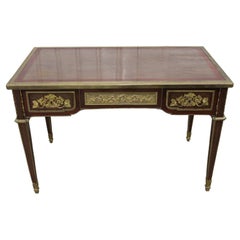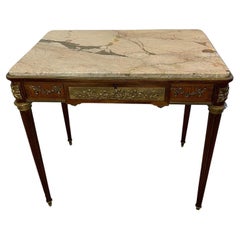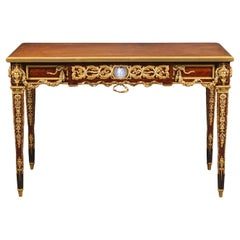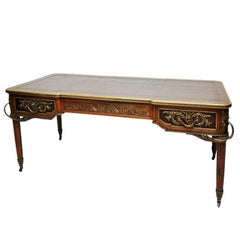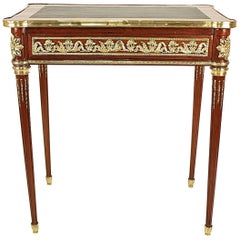Louis Xvi Bureau Plat Jean Henri Riesener
20th Century French Desks and Writing Tables
Bronze
Antique Late 19th Century Desks and Writing Tables
Bronze
Antique Early 19th Century French Louis XVI Desks and Writing Tables
Marble, Brass, Bronze
Antique 19th Century French Louis XVI Desks and Writing Tables
Bronze
Recent Sales
Antique 19th Century French Louis XVI Desks and Writing Tables
Bronze
Antique 1880s French Louis XVI Desks and Writing Tables
Brass
Antique Late 18th Century French Louis XVI Desks and Writing Tables
Bronze
20th Century Louis XVI Desks and Writing Tables
Brass, Bronze
Antique 19th Century English Louis XVI Tables
Antique 19th Century English Louis XVI Tables
Oak
People Also Browsed
20th Century French Empire Coffee and Cocktail Tables
Malachite, Bronze, Ormolu
Antique Mid-19th Century English High Victorian Taxidermy
Other
Antique 19th Century French Napoleon III Stairs
Walnut
19th Century Rococo Figurative Paintings
Oil
19th Century Academic Nude Paintings
Oil
17th Century Old Masters Paintings
Copper
Antique Early 1900s French Louis XVI Desks and Writing Tables
Bronze
Antique Late 19th Century French Louis XVI Grandfather Clocks and Longca...
Malachite, Ormolu
19th Century Portrait Paintings
Masonite, Oil
Antique 19th Century Italian Louis XVI Console Tables
Belgian Black Marble
Antique 15th Century and Earlier English Renaissance Beds and Bed Frames
Oak
19th Century Figurative Sculptures
Marble
Antique 1880s German Rococo Urns
Porcelain
Antique Mid-19th Century French Louis XIII Beds and Bed Frames
Walnut
Antique Late 19th Century French Louis XV Desks and Writing Tables
Ormolu
20th Century Italian Baroque Armchairs
Velvet, Giltwood
A Close Look at Louis-xvi Furniture
Reflecting the final era of royal opulence before the upheaval of the French Revolution, antique Louis XVI furniture features more angular shapes than the Rococo curves of the Louis XV style, harkening back to the imposing grandeur of Louis XIV.
Dating between 1750 and 1800, an era that overlapped with the last king of France whose reign was cut short by the guillotine, Louis XVI furniture, known as the goût grec, is emblematic of the neoclassical revision that French furniture underwent during the second half of the 18th century.
Authentic Louis XVI furniture characteristics include clean lines and carved details such as scrolls and acanthus flourishes that were inspired by ancient Greece and Rome. This was informed by a burgeoning interest in antiquity in the 18th century, owing to new archaeological excavations at sites including Pompeii and Herculaneum. It largely eclipsed the more East Asian–influenced ornamentation of Louis XV for something more geometric and symmetrical.
The Louis XVI style was defined by what was being created for the palatial rooms at Versailles and Fontainebleau, particularly for the queen, with cabinetmaker Jean-Henri Riesener being a favorite of Marie-Antoinette’s for his luxurious pieces accented with gilded bronze and marquetry. Furniture maker Jean-Baptiste-Claude Sené was also a major designer of the period, with his pieces for the royal residences adorned with giltwood and neoclassical touches like tapered columns for chair legs and laurel leaf carvings. Cabinetmaker Adam Weisweiler occasionally incorporated into his furniture porcelain panels produced by Sèvres, a popular manufacturer of European ceramics that served the crown with serveware, vases and other decorative objects.
Find a collection of antique Louis XVI seating, tables, cabinets and other furniture on 1stDibs.
Finding the Right Desks-writing-tables for You
Choosing the perfect writing desk or writing table is a profoundly personal journey, one that people have been embarking upon for centuries.
Queen Atossa of Persia, from her writing table circa 500 B.C., is said to have been the originator of the art of handwritten letters. Hers was reportedly the first in a long and colorful history of penned correspondence that grew in popularity alongside literacy. The demand for suitable writing desks, which would serve the composer of the letters as well as ensure the comfort of the recipient naturally followed, and the design of these necessary furnishings has evolved throughout history.
Once people began to seek freedom from the outwardly ornate styles of the walnut and rosewood writing desks and drafting tables introduced in the name of Queen Victoria and King Louis XV, radical shifts occurred, such as those that materialized during the Art Nouveau period, when designers longed to produce furniture inspired by the natural world’s beauty. A prime example is the work of the famous late-19th-century Spanish architect Antoni Gaudí — his rolltop desk featured deep side drawers and was adorned with carved motifs that paid tribute to nature. Gaudí regularly combined structural precision with decorative elements, creating beautiful pieces of furniture in wood and metal.
Soon afterward, preferences for sleek, geometric, stylized forms in furniture that saw an emphasis on natural wood grains and traditional craftsmanship took hold. Today, Art Deco desks are still favored by designers who seek to infuse interiors with an air of luxury. One of the most prominent figures of the Art Deco movement was French decorator and furniture designer Émile-Jacques Ruhlmann. With his use of neoclassical motifs as well as expensive and exotic materials such as imported dark woods and inlays of precious metals for his writing desks, Ruhlmann came to symbolize good taste and modernity.
The rise in appreciation for Scandinavian modernism continues to influence the design of contemporary writing desks. It employs the “no fuss” or “less is more” approach to creating a tasteful, sophisticated space. Sweden’s master cabinetmaker Bruno Mathsson created gallery-worthy designs that are as functional as they are beautiful. Finnish architect Alvar Aalto never viewed himself as an artist, but, like Mathsson, his furniture designs reflected a fondness for organic materials and a humanistic approach. Danish designers such as Hans Wegner introduced elegant shapes and lines to mid-century desks and writing tables, often working in oak and solid teak.
From vintage desks to contemporary styles, 1stDibs offers a broad spectrum of choices for conducting all personal and business writing and reading activities.

